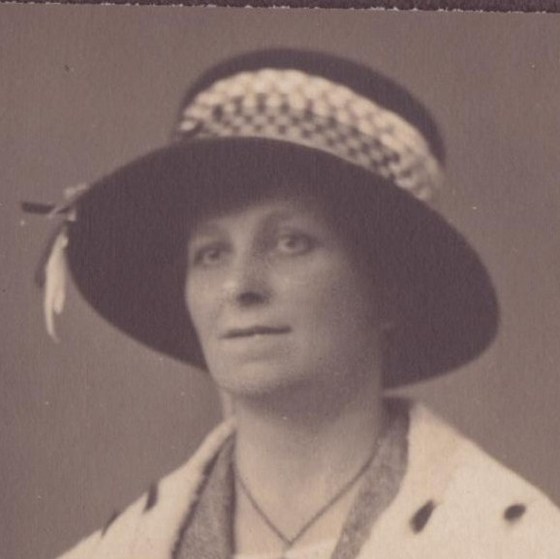
Willimina ‘Minnie’ Melville
28/04/1886–11/02/1967
Minnie was born in Johnshaven, Scotland and volunteered for the British Red Cross in November 1916. She was initially stationed at Whalley Military Hospital as a VAD nurse from 4/11/1916 to 26/06/1917, before moving to Catterick Camp Military Hospital, again as a nurse, from 15/01/1918 until 6/04/1919.
Willimina Melville, now Mrs Scales married James Jarvis Scales in 1922 and they were married up until her death on the 11th of February 1967. Minnie and Jim had emigrated and were living in Nanaimo, British Columbia, Canada in 1967.
This information, provided by Alathea Anderssohn has been drawn from the Imperial War Museum’s ‘Lives of the First World War’ archive.
Explore more memories from the ribbon
-
Alfred Myers
Alfred Myers came from a large family in East Cleveland and before the war worked with two of his brothers in the ironstone mines. A member of the Independent Labour Party and a devout Wesleyan Methodist, he played a key role in his local community. He was a tenor in the Wesleyan Carlin How choir, a Sunday school superintendent and trustee of the local church. Myer’s service record survives and records the process of his arrest and sentencing in cold, hard terms. One month after his posting he was arrested and court-martialled. Initially he was sentenced to death but this was commuted to 10 years imprisonment. At his hearing for exemption from compulsory military service, Myers asserted his belief in an international brotherhood of man, and stated that he ‘could not conscientiously kill, nor assist in killing’. But like so many others he was only granted exemption from combatant service and was sent to the Non-Combatant Corps at Richmond Castle. In the cells at Richmond, Myers’s tenor voice was put to good use. With two other conscientious objectors, Brocklesby and Gaudie, he sang the hymn ‘Nearer My God to Thee’ in three-part harmony. Myers’s performance wasn’t as perfect as the other prisoners hoped, however – they had to bang on the cell floor to keep him in time. Following his ordeal with the rest of the Richmond Sixteen in France, Myers was sent first to Dyce Camp, near Aberdeen, and then Maidstone prison. Others of the Richmond Sixteen were also…
-
Arthur John Buchanan Richardson
Arthur John Buchanan Richardson Arthur was born in Guisborough North Yorkshire in the first quarter 1895. He was the eldest son of Colonel William Richardson, a solicitor of Guisborough and his wife Averil Mary, daughter of Arthur Buchannan, also a solicitor of Guisborough. Arthur entered Rugby Public School, Warwickshire, in 1909 and left in 1913. In August 1913 he entered as an Articled Clerk in the firm of Solicitors founded by his great grandfather and carried on by his grandfather. He received his Commission as a 2nd Lieutenant in the 4th Battalion, The Yorkshire Regiment in June, 1913, and went to camp with them in August, 1913. He was again in camp in August 1914, at Colwyn Bay, when War broke out. The Regiment was recalled into training at Darlington, when he was given the command and a new Company of Signallers. He next went with the Battalion to Newcastle on Tyne, on coastal defence. Arthur would not die leading his men over no-man’s-land or in some heroic fighting. He would die of meningitis, contracted on service, in his billet at Newcastle on 4th January 1915. Three months later, the Battalion went out to France. Arthur was just 19 years old. A local newspaper report, headed “Cleveland Mourns the Death of a Gallant Officer”, provides details of a military funeral at Guisborough Church attended by local dignitaries: ‘The coffin was borne by men of the 4th Battalion, with fellow Officers Colonel Bell, Captain Charlton and Lts Williams and Jervelund present….
-
Austin Graham
Submitted by Pat Burgess. The Graham family were local to Barnard Castle, they lived on The Bank, where father John had a chemist and grocery business. John Austin was born on 2 March 1872. After his time at school from 1886 until 1889, he took a Electrical Engineering apprenticeship. Later he started an electrical business with his brother – Graham Brothers Electrical Engineers in Middlesbrough. He was secretary of the Saltburn R.N.L.I. and a gifted operatic singer. Serving as a territorial captain, Austin Graham was with the 4th battalion when war broke out in August of 1914. He landed with the battalion at Boulogne on April 18th 1915 when the battalion was almost straight away thrown into the 2nd battle of Ypres. On April 24th Captain Graham and his men had their first taste of action in fierce fighting during the Battle of St Julien. On Whit Monday 1915 the battalion were in trenches astride the Menin Road at Hooge and Austin Graham was badly gassed and hospitalised with his injuries. In early 1918 the battalion were back in the Ypres sector and when the German Spring Offensive opened on March 21st they were in a position close to Hancourt. There followed nine days of fighting on the retreat under the enemy onslaught. A brief rest at Bethune followed this and then on April 8th the battalion was moved up to take part in the Battle of the Lys. By now CO of the 4th battalion Major Austin Graham was…
